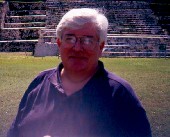
David F. Grose
Home
SIMSMC Philosophy
Description
Objectives and Design
Instructors
Program Structure
Modules
Evening Lectures
Field Trips
Schedule
June 2005 SIMSMC
Participants
Module 1
Module 2
June 2004 SIMSMC
Participants
Module 1
Module 2
June 2003 SIMSMC
Participants
Module 1
Module 2
June 2002 SIMSMC
Participants
Module 1
Module 2
Comments
Travel & Housing
Who Should Apply?
NSF Support
How to contact us
Requirements for
Applicants
APPLY!
|
||
B.A. Classics and History, St. Olaf College, 1966 American Academy in Rome, 1969-1970, 1972-1974 Ph.D. History and Archaeology, Harvard University, 1975 Fellow, American Academy in Rome and Society of Antiquaries, London David Grose is an archaeologist and ancient historian with primary research interests in social, economic, and technological history. He specializes in ancient, medieval, and Islamic glass found in Europe, the Mediterranean region, and Western and Eastern Asia. He has worked on numerous excavations over the past quarter century. These include sites in Britain, Italy, Greece, Turkey, Cyprus, Tunisia, Egypt, and Israel. He also has excavated for the Smithsonian Institution on native American sites, namely Arikara/Hidatsa villages in the Dakotas, and most recently has surveyed the finds of western archaeological artifacts along the route of the so-called Silk Road in China, Korea, and Japan. He has been actively involved with many of the major museums of North America, Europe, and Asia.
At the present time, he is involved in a ten-year project with American
and European colleagues to publish a comprehensive volume on the
history of glass (including archaeometry, art history, dirt archaeology,
economic and social history, technology, etc.) He firmly believes
that a multi-disciplinary approach to archaeological discoveries,
including Material Sciences, is essential to understanding more
fully the societies that preceded us, yet still inform us the about
development of human civilizations. The integration of the sciences,
social sciences, and humanities is very important in the reconstruction
of the ancient past. Selected Publications Early Ancient Glass: The Core-Formed, Cast, Rod-Formed Vessels and Objects from the Late Bronze Age to Early Roman Times, 1600 BC to AD 50, New York, 1989, pp. 453. "The Origins and Early History of Glass, " The History of Glass, London, 1984. "The Formation of the Roman Glass Industry," Archaeology
36 (1983) 38-45.
Back |
||
